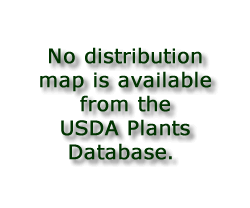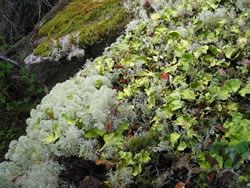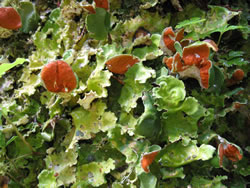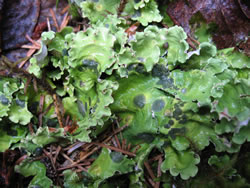Plant of the Week
 The USDA Plants Database does not provide a range map for Nephroma arcticum.
The USDA Plants Database does not provide a range map for Nephroma arcticum.
 Arctic kidney lichen (green) along with Reindeer lichen (white) on rocks in Alaska. Photo by Karen Dillman, U.S. Forest Service.
Arctic kidney lichen (green) along with Reindeer lichen (white) on rocks in Alaska. Photo by Karen Dillman, U.S. Forest Service.
 Dark bumps on the surface of the lichen are the cephalodia, where the cyanobacteria reside. Photo by Karen Dillman, U.S. Forest Service.
Dark bumps on the surface of the lichen are the cephalodia, where the cyanobacteria reside. Photo by Karen Dillman, U.S. Forest Service.
 Close up of the reddish-brown apothecia of the Arctic Kidney lichen in Alaska. Photo by Karen Dillman, U.S. Forest Service.
Close up of the reddish-brown apothecia of the Arctic Kidney lichen in Alaska. Photo by Karen Dillman, U.S. Forest Service.
Arctic Kidney Lichen (Nephroma arcticum (L.) Torss.)
By Karen Dillman, Tongass National Forest
Arctic kidney lichen is a member of the genus Nephroma, which has approximately 10 species in North America. The common name “kidney” lichen is from the kidney- shaped apothecia (spore producing structures) possessed by all members of the genus.
The Arctic kidney lichen body (thallus) is made of interwoven fungal threads housing two photosynthetic organisms (green algae Coccomyxa and cyanobacteria Nostoc cells). The fungal threads are not able to feed themselves directly and must rely on the Coccomyxa and Nostoc to produce food from the sun’s energy and water. The Coccomyxa cells are embedded in the thallus and the Nostoc cells are concentrated in pockets; looking like small, dark bumps on the upper surface called cephalodia. Like the Coccomyxa , the Nostoc harvest energy from the sun, but also extract or “fix” nitrogen gas from the air and convert it into a form useful to the fungus and also other organisms in the vicinity. Nitrogen-fixing lichens are main contributors of nitrogen in generally nutrient -poor habitats such as alpine tundra, conifer forests, and newly disturbed areas.
The Arctic kidney lichen is large (colonies up to 12 inches across or more), yellowish-green when dry and bright yellow green when wet. The lower surface is pale tan at the edges and darker brown towards the center. The broad lobes of the thallus are flattened to irregularly wrinkled, with smooth to wavy margins. The apothecia are large (up to an inch across) and orange-brown.
In North America, the Arctic Kidney lichen is one of only two lichens in the genus Nephroma that contain green algae. The other Nephroma lichen with green algae is the Alpine Kidney lichen (N. expallidum). It also contains cyanobacteria in cephalodia, but they are not visible on the upper surface. Also, the lobes are narrower and the margins are very ruffled and crinkled. The Alpine Kidney lichen’s distribution is more restricted to arctic tundra and northern boreal woodlands. All other Nephroma lichens contain only Nostoc as a photosynthetic partner and are not bright green, but rather dark brown when wet.
The Arctic kidney lichen lives mainly on the ground in habitats with lots of natural light, such as alpine or open forests. It also occurs over old stumps and down logs, over moss-covered rocks, and sometimes on trees in wet, cold environments. In coastal Alaska, it is found on the trunks of Sitka spruce (Picea sitchensis) and Western Hemlock (Tsuga heterophylla) forests at higher elevations.
Some indigenous cultures in Alaska used this lichen as a food. It was boiled and eaten with crushed fish eggs. It is also reported as a medicinal remedy. It is eaten by ungulates of the North, including caribou and mountain goats, and many invertebrates.
For More Information
- PLANTS Profile - Nephroma arcticum, Arctic kidney lichen
- Celebrating Wildflowers: Lichens
- United States Forest Service National Lichens & Air Quality Database and Clearinghouse
- Brodo, I.M., S.D. Sharnoff, and S. Sharnoff. 2001. Lichens of North America. Yale University Press. New Haven.

